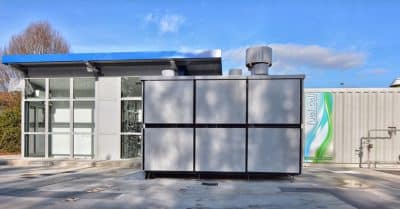Fuel cell power plants are the top class of stationary applications. They are the most difficult systems to design and the market for them is the toughest to survive. Companies engaging in this business have often come crashing down or were saved in spectacular fashion by mere chance. But there are some which have mastered the market’s ups and downs and new entrants who are willing to try. The following will offer readers an outline of market players, projects and technologies, in addition to the table.
There are now over half a dozen companies that manufacture stationary fuel cell systems ranging from 100 kilowatts to 10 megawatts. The power source for these systems used to be either a solid oxide or a molten carbonate fuel cell, but proton exchange membranes have made headway in recent years. Even phosphoric acid fuel cells remain an option, despite receiving scarce news coverage at times.
Bloom Energy
Bloom Energy, a globally operating provider of interconnection services, began to develop solid oxide fuel cells, or SOFCs, in 2001. But the company, based in Sunnyvale, USA, became more widely known no earlier than the beginning of 2010. Even now, details about Bloom’s systems are few. This strategy has allowed CEO KR Sridhar to build a broad knowledge base on high-temperature fuel cells without being constantly in the public eye.
Eight years ago, the cash-strong business started producing one Bloom Box each day. Meanwhile, its systems have been installed on the premises of many large corporations. In July 2008, Bloom delivered a first 100-kilowatt installation to Google. Over the following two years, it set up units at eBay’s headquarters in San Jose. Other big customers collaborating with Bloom during that period were Coca-Cola, FedEx and Walmart.
…
“There is no greater compliment and validation of our energy platform than to have our existing customers continue to expand their deployments of Bloom Energy Servers, and today, Equinix is doing that in a big way.”
R. Sridhar, CEO of Bloom Energy
Convion
Another company focused on SOFC development is Finnish Convion, founded in 2012. Its ceramic stacks come from suppliers such as Elcogen, a fuel cell manufacturer based in Tallinn, Estonia. Established by CEO Enn Õunpuu in 2001, Elcogen has grown into an R&D facility employing 28 staff members.
The Estonian business said that its fuel cells had operating temperatures of as low as 600 °C to 650 °C, showed more than 74 percent efficiency and cost less than EUR 500 per kilowatt. Typical SOFC systems operate at 750 °C to 900 °C. The lower temperature threshold is said to allow for the use of inexpensive materials and lead to reduced degradation.
…
Mitsubishi
Meanwhile, Mitsubishi Hitachi Power Systems announced that it had received an initial order for its combined fuel cell and gas turbine system. The hybrid power plant, which runs on natural gas, consists of a solid oxide fuel cell and a mini gas turbine. Electricity is generated first in the fuel cell, through the reaction of hydrogen and carbon monoxide with air, before the hot exhaust reaches the turbine to produce more power and push electrical efficiency above 65 percent.
…
FuelCell Energy
One influential market player is FuelCell Energy, an American manufacturer that started developing molten carbonate fuel cells, or MCFCs, more than 20 years ago. In Germany, the corporation initially entered into partnership with MTU Friedrichshafen before the latter outsourced its fuel cell division to MTU CFC Solutions and from there to MTU Onsite Energy. The division was then incorporated into the Tognum Group, which ultimately abandoned the business altogether. Eighteen months later, FuelCell Energy acquired the remaining assets and founded a German subsidiary, FuelCell Energy Solutions. Its longtime CEO Andreas Frömmel left in April 2017 and was replaced by Klaus Ullrich the following month. In the meantime, the position has become vacant again.
…
From UTC to Doosan
United Technologies Corporation began researching phosphoric acid fuel cells, or PAFCs, half a century ago. In 1985, UTC Power partnered with Toshiba to establish International Fuel Cells. The joint venture and Toshiba then founded ONSI Corporation in 1991. The new business set up more than 150 fuel cell power plants, type ONSI PC25. But the plants were too costly, stack lifetime too low. Following years of uncertainty, ClearEdge Power, a company backed through venture capital, acquired the expertise originally sourced from UTC. ClearEdge, however, had to file for bankruptcy protection in 2014. Its PAFC technology lives on, as Doosan Fuel Cell America took over the reins the same year and has since been manufacturing the 400-kilowatt PureCell® Model 400. Doosan Fuel Cell is a subsidiary of South Korean Doosan Corporation, which employs 43,000 people in 38 countries.
…
Fuji Electric
Fuji Electric is another PAFC manufacturer. In Germany, at least, the company’s offering is mainly known among fire safety professionals. In 2015, it acquired N2telligence, a small northern German startup that has been in the fuel cell business for years. N2telligence uses the low-oxygen air exhaust from its fuel cells to reduce the oxygen content inside a building and prevent fires from breaking out.
…
Hydrogenics
Hydrogenics, a Canadian manufacturer listed on the stock exchange (see p. 50), is a long-standing player on the market for proton exchange membrane fuel cells, or PEMFCs. It not only has a variety of stationary and vehicle systems for sale but offers scalable fuel cell solutions. The product portfolio ranges from 10-kilowatt R10s to R20s, R30s and R120s and goes up to multi-megawatt systems, for which the corporation combines several 120-kilowatt racks.
…
Toshiba
Toshiba seems to be one step ahead of its competitors. The Japanese manufacturer began work on PAFCs in 1978 and put into operation its fifth H2One™ system in April 2017. This off-grid system, which produces renewably sourced hydrogen via electrolysis and converts the gas into power via fuel cells, supplies a Japan Railways station in Kawasaki City. It reduces the amount of energy needed from the public grid and serves as an off-grid uninterruptible supply system to provide the station with hot water and electricity.
…



























Excellent corporate overview. I liked the summary immensely. Your company is lucky to have such an excellent historian on board. I would like info on putting two hydrogen power plants into operation in California. I go to California Business Hydrogen seminars regularly. http://www.californiahydrogen org
I would like to have info on your Korean hydrogen powered plant with Hahaha.
http://www.hanwha.com